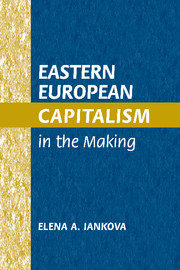Book contents
- Frontmatter
- Contents
- Acknowledgments
- List of Abbreviations
- 1 Hybrid Capitalism in the Making
- 2 The Corporatist Legacy of State Socialism
- 3 Bulgaria's National Tripartism
- 4 National Social Dialogue in Poland
- 5 The Politics of Sectoral Tripartism
- 6 The Politics of Regional Tripartism
- 7 Conclusions: Transiency and Continuity
- Tables
- References
- Index
7 - Conclusions: Transiency and Continuity
Published online by Cambridge University Press: 30 July 2009
- Frontmatter
- Contents
- Acknowledgments
- List of Abbreviations
- 1 Hybrid Capitalism in the Making
- 2 The Corporatist Legacy of State Socialism
- 3 Bulgaria's National Tripartism
- 4 National Social Dialogue in Poland
- 5 The Politics of Sectoral Tripartism
- 6 The Politics of Regional Tripartism
- 7 Conclusions: Transiency and Continuity
- Tables
- References
- Index
Summary
When in danger the sea-cucumber divides itself in two:
one self it surrenders for devouring by the world,
with the second it makes good its escape.
It splits violently into perdition and salvation,
into fine and reward, into what was and what will be.
In the middle of its body there opens up a chasm
with two shores that are immediately alien.
On one shore death, on the other life.
Here despair, there hope.
If a scale exists, the balance does not tip.
If there is justice, here it is.
To die as much as necessary, without going too far.
To grow back as much as needed, from the remnant that survives. …
Wislawa Szymborska, AutotomyIn the aftermath of the 1989 breakthrough, two important trends, one harking to the past and one to the future, shaped the emerging new relationship between a politically discredited state and a politically disillusioned, economically choked working society.
First, a confused history of almost half a century cast its long shadow. The year 1989 marked the collapse of the “dictatorship of labor” and the outpouring of decades-old worker aspirations for greater input in enterprise and upper-level governance that erupted in spectacular worker protests against the party-state. The corporatist-like links between a reforming state and the working society that began to develop after 1989 were historically facilitated by these worker aspirations.
- Type
- Chapter
- Information
- Eastern European Capitalism in the Making , pp. 172 - 186Publisher: Cambridge University PressPrint publication year: 2002



